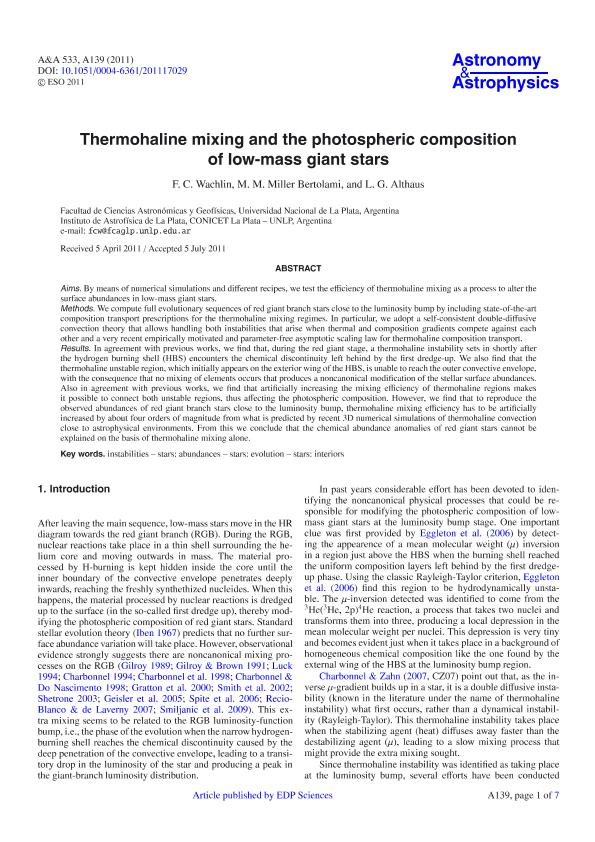Artículo
Thermohaline mixing and the photospheric composition of low-mass giant stars
Fecha de publicación:
09/2011
Editorial:
Edp Sciences
Revista:
Astronomy And Astrophysics
ISSN:
0004-6361
Idioma:
Inglés
Tipo de recurso:
Artículo publicado
Clasificación temática:
Resumen
Aims. By means of numerical simulations and different recipes, we test the efficiency of thermohaline mixing as a process to alter the surface abundances in low-mass giant stars.
Methods. We compute full evolutionary sequences of red giant branch stars close to the luminosity bump by including state-of-the-art composition transport prescriptions for the thermohaline mixing regimes. In particular, we adopt a self-consistent double-diffusive convection theory that allows handling both instabilities that arise when thermal and composition gradients compete against each other and a very recent empirically motivated and parameter-free asymptotic scaling law for thermohaline composition transport.
Results. In agreement with previous works, we find that, during the red giant stage, a thermohaline instability sets in shortly after the hydrogen burning shell (HBS) encounters the chemical discontinuity left behind by the first dredge-up. We also find that the thermohaline unstable region, which initially appears on the exterior wing of the HBS, is unable to reach the outer convective envelope, with the consequence that no mixing of elements occurs that produces a noncanonical modification of the stellar surface abundances. Also in agreement with previous works, we find that artificially increasing the mixing efficiency of thermohaline regions makes it possible to connect both unstable regions, thus affecting the photospheric composition. However, we find that to reproduce the observed abundances of red giant branch stars close to the luminosity bump, thermohaline mixing efficiency has to be artificially increased by about four orders of magnitude from what is predicted by recent 3D numerical simulations of thermohaline convection close to astrophysical environments. From this we conclude that the chemical abundance anomalies of red giant stars cannot be explained on the basis of thermohaline mixing alone.
Palabras clave:
Instabilities
,
Abundances of Stars
,
Evolution of Stars
,
Interior Stars
Archivos asociados
Licencia
Identificadores
Colecciones
Articulos(IALP)
Articulos de INST.DE ASTROFISICA LA PLATA
Articulos de INST.DE ASTROFISICA LA PLATA
Citación
Wachlin, Felipe Carlos; Miller Bertolami, Marcelo Miguel; Althaus, Leandro Gabriel; Thermohaline mixing and the photospheric composition of low-mass giant stars; Edp Sciences; Astronomy And Astrophysics; 533; a139; 9-2011; 139-145
Compartir
Altmétricas




